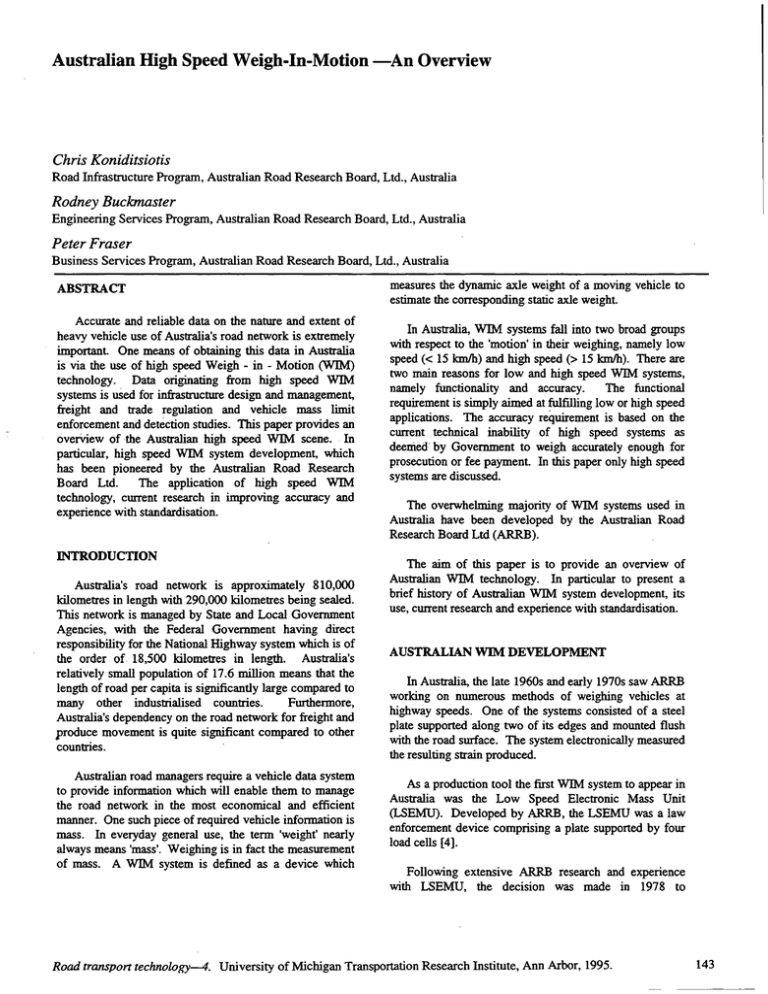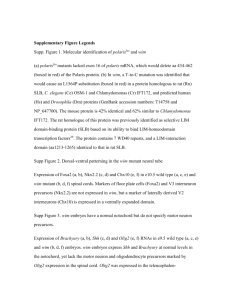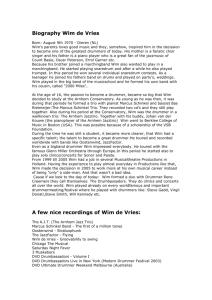Australian High Speed Weigh-In-Motion -An Overview Chris Koniditsiotis Rodney Buckmaster
advertisement

Australian High Speed Weigh-In-Motion -An Overview Chris Koniditsiotis Road Infrastructure Program, Australian Road Research Board, Ltd., Australia Rodney Buckmaster Engineering Services Program, Australian Road Research Board, Ltd., Australia Peter Fraser Business Services Program, Australian Road Research Board, Ltd., Australia ABSTRACT Accurate and reliable data on the nature and extent of heavy vehicle use of Australia's road network is extremely important. One means of obtaining this data in Australia is via the use of high speed Weigh - in - Motion (WIM) technology .. Data originating from high speed WIM systems is used for infrastructure design and management, freight and trade regulation and vehicle mass limit enforcement and detection studies. This paper provides an overview of the Australian high speed WIM scene. In particular, high speed WIM system development, which has been pioneered by the Australian Road Research Board Ltd. The application of high speed WIM technology, current research in improving accuracy and experience with standardisation. INTRODUCTION Australia's road network is approximately 810,000 kilometres in length with 290,000 kilometres being sealed. This network is managed by State and Local Government Agencies, with the Federal Government having direct responsibility for the National Highway system which is of the order of 18,500 kilometres in length. Australia's relatively small population of 17.6 million means that the length of road per capita is significantly large compared to many other industrialised countries. Furthermore, Australia's dependency on the road network for freight and produce movement is quite significant compared to other countries. Australian road managers require a vehicle data system to provide information which will enable them to manage the road network in the most economical and efficient manner. One such piece of required vehicle information is mass. In everyday general use, the term 'weight' nearly always means 'mass'. Weighing is in fact the measurement of mass. A WIM system is defined as a device which measures the dynamic axle weight of a moving vehicle to estimate the corresponding static axle weight. In Australia, WIM systems fall into two broad groups with respect to the 'motion' in their weighing, namely low speed « 15 kmJh) and high speed (> 15 kmJh). There are two main reasons for low and high speed WIM systems, namely functionality and accuracy. The functional requirement is simply aimed at fulftlling low or high speed applications. The accuracy requirement is based on the current technical inability of high speed systems as deemed by Government to weigh accurately enough for prosecution or fee payment. In this paper only high speed systems are discussed. The overwhelming majority of WIM systems used in Australia have been developed by the Australian Road Research Board Ltd (ARRB). The aim of this paper is to provide an overview of Australian WIM technology. In particular to present a brief history of Australian WIM system development, its use, current research and experience with standardisation. AUSTRALIAN WIM DEVELOPMENT In Australia, the late 1960s and early 1970s saw ARRB working on numerous methods of weighing vehicles at highway speeds. One of the systems consisted of a steel plate supported along two of its edges and mounted flush with the road surface. The system electronically measured the resulting strain produced. As a production tool the first WIM system to appear in Australia was the Low Speed Electronic Mass Unit (LSEMU). Developed by ARRB, the LSEMU was a law enforcement device comprising a plate supported by four load cells [4]. Following extensive ARRB research and experience with LSEMU, the decision was made in 1978 to Road transpon technology-4. University of Michigan Transportation Research Institute, Ann Arbor, 1995. 143 ROAD TRANSPORT TECHNOLOGY--4 investigate the application of the system to high speed weighing. This culminated in the first generation High Speed Electronic Mass Unit (HSEMU) [3] [5J. Australia has also pioneered the use of strain gauge weighing sensor systems. The Main Roads Department Westem Australia, developed a bridge based strain gauge system called AXWAY [1]. Experience with AXWAY led the Main Roads. Department - Western Australia in conjunction with ARRB to develop CULWAY [2] in 1985. With CULWAY, strain gauges were mounted onto a culvert rather than a bridge. A Multi lane CULWAY system [5J able to monitor up to four lanes and produce additional information such as vehicle position, vehicle width and the number of types per axle was completed in the early 1990s. From the late 1970s, other WIM systems were introduced into Australia. The Department of Main Roads - New South Wales installed the German built PAT DAW 100 high speed bending plate WIM system in 1985. Furthermore, the same Agencies installed a United States bridge based strain gauge system called FASTWEIGH. During the mid-1980s, ARRB commenced using the temporary Golden River Weighman capacitance pad weighing sensor based system [6J. APPLICATIONS OF WIM TECHNOLOGY As in many other high technology fields, the WIM discipline has for many years been technology driven. While this might have been inevitable in the early stages of development, the current level of technology allows WIM to now become application driven. Identified are a number of Australian uses and applications, which can be categorised into three main areas as follow. • • • Infrastructure design and management Freight/trade planning and regulation Enforcement and detection Within each of these three broad areas are overall network and specific project level applications. A key element running through all the areas is the advancement of that area through research. For instance, the technological advances in the collection of vehicle mass data in the road pavements area has developed from people estimating vehicle mass by standing at the roadside to the use of high speed WIM systems. This advance has produced a better estimate of the actual vehicle traffic loads and thus more accurate data being used either in the initial design or subsequent rehabilitation. Furthermore, sufficient data using WIM systems have been collected to allow upgrades and revisions to actual road pavement design and management procedures and formulae. 144 Ultimately the choice of WIM system to develop or purchase, the question of its accuracy, network or project level, permanent or temporary installation, conspicuousy requirements, its life cycle calibration and costs, data storage and output, just to name a few, is fundamentally inherent to its intended purpose and application. Furthermore, these key issues are not clear cut but interconnected and in some cases dependent on each other. For example, the versatility, ease of use and speed of installation of a temporary high speed WIM system was found to balance its relative inaccuracy as compared to other more permanent systems [6]. The relative accuracy requirements for different network and project level WIM applications, which are detailed below, are shown in Figure 1. WEIGHING FOR INFRASTRUCTURE DESIGN AND MANAGEMENT It is somewhat difficult to quantify the financial benefits or returns to the Australian road infrastructure network which are due to WIM technology. Specific cases though can be quantified. A number of high speed WIM surveys in Australia's National capital - Canberra have indicated a significantly lower number of Equivalent Standard Axles (ESAs) per commercial vehicle (heavy vehicle) than previously has been used in design. In the past, 1.9 ESAs per commercial vehicle was representative for certain road types in Canberra, whereas an ESA value of 0.75 via WIM surveys was found to be more appropriate. In the rehabilitation of a two lane carriageway only 500 metres long, this change in ESA values produced a saving of $AUSI5,OOO. Applications in weighing for Infrastructure Design and Management are as follows. Network Level • Collection of heavy vehicle mass data for the development of infrastructure asset design and management strategies: Bridge management strategies Pavement management strategies Determination and adjustment of loading criteria for bridge codes Input into pavement and bridge management systems Knowledge of axle configurations and individual axle masses for derivation of group average ESAs for commercial vehicles and axle configurations. Acquisition of information on the number and types of heavy vehicle axles Collection of heavy vehicle mass data for the • planning of heavy vehicle routes • Enhanced risk management and reliability in pavement design WEIGH-IN-MOTION Project Level • Investigation of premature deterioration of specific road pavements and bridges, encompassing the collection of heavy vehicle mass data for specific rehabilitation and maintenance designs Applications in weighing for Freightffrade Planning and Regulation are as follows. Network Level • • WEIGHING FOR REGULATION FREIGHTfTRADE AND • In the past 20 years, Australian road freight has risen from 27 billion to 95 billion tonne-kilometres per year. Furthermore the proportion of road freight compared to all freight modes (road, rail, sea and air) has increased from 20 to 34 per cent. It is difficult to put an economic value on WIM data for freight/trade planning and regulation. However, as a broad indication, the annual cost of road freight in Australia is about $AUS30 billion. If, through better load data, road investment were better targeted to the needs of the road freight industry such that industry costs· were reduced by only 0.1%, this would represent an annual benefit of $AUS30 million. • • Collection of Gross Vehicle Mass data for ascertaining aggregate freight movements and the development of freight/trade strategies Collection of truck mass data for the planning of specific heavy vehicle routes Ascertaining the utilisation of the load carrying capacity of freight/trade vehicles Ascertaining the extent of road use by different classes of heavy vehicles for potential taxation or cost attribution . Input of vehicle mass data is required for financial investment and work programming. This data is also used in revenue forecasting, energy supply, consumption and forecasting as well as commodity movement studies. Project Level • • Monitoring of material movement at entry or departure points at quarries, mines, ports and freight depots. Collection of Gross Vehicle Mass and Individual Axle Mass data as a basis for toll collection (eg. road and bridge tolls, ferry boat operators). APPLICATION LEVEL increase in accuracy of mass estimation Figure 1. Relative required accuracy of different WIM applications 145 ROAD TRANSPORT TECHNOLOGY-4 WEIGHING FOR ENFORCEMENT AND DETECTION Project Level • The protection of specific road pavements, bridges or unsound structures (road based or otherwise) from vehicles above a pre - defined mass. To ensure that overloaded vehicles do not cause excessive damage to roads, Australia has imposed axle load limits on vehicles. Successful detection of overloaded vehicles is expected to lead to a reduction in the overall road network rehabilitation and maintenance costs. AUSTRALIAN WIM TECHNOLOGY As of the date of this paper, there are currently in Australia five high speed WIM system types, incorporating a wide range of technology including bending plate, capacitance pad, capacitance strip, load cell and strain gauge weighing sensors. In total there are currently 139 high speed WIM sites in Australia of which 90 per cent were developed by ARRB (Table 1). Weighbridges have been deemed by some to be too expensive to operate, with their fixed location allowing enforcement avoidance. Furthermore, portable static scales are regarded as too slow and cumbersome to operate. The resulting benefits to the community accrue from reduced disruption to the transport industry through the selective interception of overloaded vehicles. The effects on industry using heavy vehicles would be significant in terms of reduced disruption to general operations through the process of targeting overloaded vehicles only. Some Australian State Road Agencies have identified a potential ten-fold reduction in disruption costs utilising this process as compared with the existing static process of total interception. Applications in weighing for Detection are as follows. Enforcement CULWAY CULWAY is a WIM system which uses eXIstmg standard concrete culverts as dynamic scales to measure the weight of axles as they pass over the culvert. It is currently designed to record up to four lanes of traffic, it can be installed and operated at low cost and offers unmanned, automatic weighing of vehicles at highway speeds (Figure 2). The system's accuracy is such that 95 per cent of vehicles weighed are recorded within 10 per cent of their static weight. and Network Level • Screening or filtering high speed WIM systems designed to improve the efficiency of more accurate static weighing systems or low speed WIMsystems • Collection of Gross Vehicle Mass and Individual Axle Mass data for the development of enforcement strategies allowing efficient utilisation of enforcement resources Strain-gauged transducers are attached to the roof of a culvert (Figure 3). The weight is recorded by measuring the bending strain caused by the axle load on the culvert. The strain signals are measured and recorded as vehicles pass, by a portable data acquisition system, which is stored in a steel box by the road-side or in the actual culvert (Figure 2). Table 1 - High Speed WIM Systems Used in Australia 146 Golden River Marksman 660 Capacitance Strip Golden River Weighman PATDAW Capacitance Pad Bending Plate Australia United Kingdom Germany 5 2 South Africa! United Kingdom 2 WIMSystem Name CULWAY HSEMU Weighing Sensor Type Strain Gauge Load Cell Country of Origin Australia Number of sites in Australia 120 10 WEIGH-IN-MOTION CULWAY is inconspicuous to the vehicles being weighed because the electronic instrumentation is located within the culvert Axle detectors on the pavement surface are used to initiate operation, classify vehicles and establish the time individual axles pass. A portable ~C is used to retrieve data at the site or a modem can be used to allow remote access. The PC may be used on site or in the office to analyse and report vehicle class, axle group and gross weights, axle spacing, ESAs, and speed distributions. There are 120 CULWAY sites throughout Australia and systems in China, Malaysia and New Zealand. Figure 2. CULWAY WIM site Figure 3. CULWAY strain - gauged transducers attached to the roof of the culvert 147 ROAD TRANSPORT TECHNOLOGY-4 HSEMU CURRENT WIM RESEARCH The HSEMU is a platform and load cell weigh-inmotion system which automatically weighs and classifies each vehicle as it passes at highway speed. The system's accuracy is such that 95 per cent of vehicles weighed are recorded within 2.5 per cent of the static weight. ARRB has an active WIM research and development program. New developments are constantly being considered. Accuracy, calibration, durability, maintainability, ease of installation, portabiIity and initial and on-going costs are all important factors which are constantly being questioned and evaluated. The HSEMU is an intelligent and highly successful high speed weigh - in - motion heavy vehicle screening system. It automatically diverts vehicles which do not conform to predefined weight, height and length parameters into a heavy vehicle checking station (Figure 4). The HSEMU system comprises the following: • • • • • Two steel weigh plate platforms (one per wheel path) mounted in a level concrete slab with each platform supported by four load cells (Figure 5) HSEMU computer A 'light curtain' for detecting the presence of vehicles over the weighing plates (Figure 5) A height detector, loop detectors and piezo axle detectors Traffic lights, controlled by the HSEMU computer to direct non conforming vehicles into the vehicle checking station comprising the enforcement weigh bridge (Figure 6) Axle detector cable pit •\ Piezo axle detectors One of the most significant areas being addressed by ARRB is the increase in accuracy of weighing sensors. In particular, developing a high speed weighing sensor capable of enforcement application accuracy. There are a number of different approaches which have been adopted as follows. • research into new weighing sensor technology improvement and modification of existing weighing sensor technology holistic approach encompassing vehicle, site and environmental characteristics. • • The research into new weighing sensors has seen ARRB investigate the applicability of piezo electric cables, hydraulic tubes and strain gauged plates (bending plates) for high accuracy and repeatability. Currently, some very impressive results are being obtained through the use of capacitance plates and fibre optic sensors. Enforcement weigh bridge I DHSEMU computer , , , ,, HSEMU weigh plates ·.----.. I • " " /'. • :-Loop detectors •I ___ J• .. '. ~ ' , , " Control room Light curtain and height detector TO MAIN HIGHWAY Figure 4. HSEMU Typical Site Layout 148 ~ WEIGH-IN-MOTION AUSTRALIAN UNIFORMITY IN WIM Due to the overwhelming majority of WIM systems used in Australia originating from one organisation, namely ARRB, there has generally been a consistent and uniform approach to the application, installation requirements, evaluation, accuracy deduction, calibration, use and reporting of WIM data. The benefits of this harmonious approach have been quite significant. For example a standard report is produced for each CULW AY site. This has permitted each of the 120 CULWAY sites to be directly compared to each other, producing a consistent analytical picture of heavy vehicle use throughout the country. Figure 5. HSEMU steel weigh plate platforms and associated light curtain 149 ROAD TRANSPORT TECHNOLOGY-4 Unfortunately these benefits have not been fully appreciated by users because the users were never part of a non-uniform environment. In the last few years with other WIM systems entering the country this harmony is being challenged. For example, because there is not an Australian standard accuracy evaluation and reporting procedure (apart from the one adopted by ARRB) the increase of WIM systems and vendors has led to disharmony and confusion. Following are only some of the practices of particular concern. • • • quoting calibration results as overall accuracy results using only one or two vehicles in a controlled experiment to derive accuracy and not conducting a larger random vehicle survey (especially as regards a permanent WIM site) reporting accuracy results in a confusing manner, ego 5 % accuracy (for 66% of vehicles weighed) or 10 % accuracy (for 95% of vehicles weighed) The disharmony issue is being addressed by the national association of Road Transport Authorities in Australia (AUSTROADS). The AUSTROADS Heavy Vehicle Load Limits and Weighing Group is recommending the adoption or development of a uniform approach to WIM system evaluation and use in Australia. Figure 6. View of the HSEMU weigh plates and traffic lights from control room 150 WEIGH-IN-MOTION CONCLUSIONS REFERENCES Weighing vehicles at highway speeds is no longer only a research task or an end in itself, but a standard production tool. There are currently 139 high speed WIM sites in Australia of which 90 per cent comprise ARRB developed equipment. 1. PE1ERS, RJ., 'AXWAY - a system to obtain axle weights', 12th ARRB Conf. Vo112, No. 1. ARRB, 500 Burwood Hwy. Vermont South, Vic., Australia. 1984. 2 PE1ERS, R.J., 'CULWAY - an unmanned and undetectable highway speed vehicle weighing system', 13th ARRB Conf. Vol13, No. 6. ARRB, 500 Burwood Hwy. Vermont South, Vic., Australia. 1986. 3. SAMUELS, S.E., 'Development and evaluation of highway speed WIMsystems in Australia', ARRB Special Report 40. ARRB, 500 Burwood Hwy. Vermont South, Vic., Australia. 1988. 4. TRlTT, RH., 'ARRB research into methods of weighing vehicles', ARRB AIR 121-1. ARRB, 500 Burwood Hwy. Vermont South, Vie., Australia. 1976. 5. BUCKMASlER, R.I., The ARRB high speed Weigh - in - Motion Systems', Application of New Technology to Transport Systems Conference Proceedings May 1995. 6. KONIDITSIOTIS, C. The Golden River capacitive pad weigh - in - motion system - its life and times' Proc. 15th ARRB Conf. Australia 1990 A critical requirement in the selection of a WIM system is ensuring that the correct system is used for the chosen application. There is not one very good system and one very poor; rather there are different systems for different needs. It was found that applications in Australia fall under three broad headings as follow: • • • Infrastructure design and management Freight/trade and regulation Enforcement and detection Benefits in the use of WIM technology in Australia have been identified not only from the traditional primary users, but also from numerous other users. These users have only recently realised and have begun to apply WIM data to their specific areas. Standard output reports such as the CULWAY standard report are being revamped and adopted to cater for other applications. New developments in WIM are constantly being considered by ARRB. Accuracy, durability, maintainability, ease of installation, portability and initial and on-going cost are all important factors which are constantly being questioned and evaluated. In order for Australian users to acquire the maximum overall benefit from WIM technology, uniformity in the following areas is required. • • • evaluation and accuracy reporting of WIM systems data output and presentation for specific applications publication and dissemination of evaluation and accuracy results by users 151








